Alemán Court
Introduction
Author-Uploaded Audio
00:00 / 00:00
Local historian Bill Worley gives a brief history of Alemán Court
Text-to-speech Audio
Alemán Court was dedicated on May 7, 1947 as part of Mexican President Miguel Alemán's visit to Kansas City. Following the 100 year anniversary of the war between the United States and Mexico, President Alemán and President Harry Truman reciprocated first-ever state visits as part of a growing economic and political alliance leading into the Cold War. On this day, President Alemán also attended the commencement ceremony for the University of Kansas City (now known as the University of Missouri-Kansas City) and received an honorary law degree. The meetings symbolized a new era in U.S.-Mexico relations following a century of conflict, as both leaders shared optimism in a day of celebration and mutual cooperation, setting the tone for the decades to come.
Images
President Miguel Aleman of Mexico with President Harry Truman on April 29, 1947
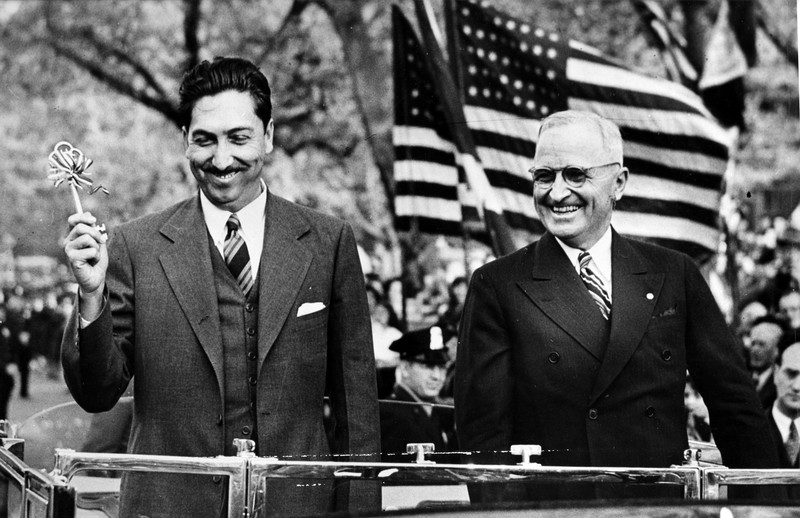
President Truman with President Aleman as they tour Mexico City on March 3, 1963
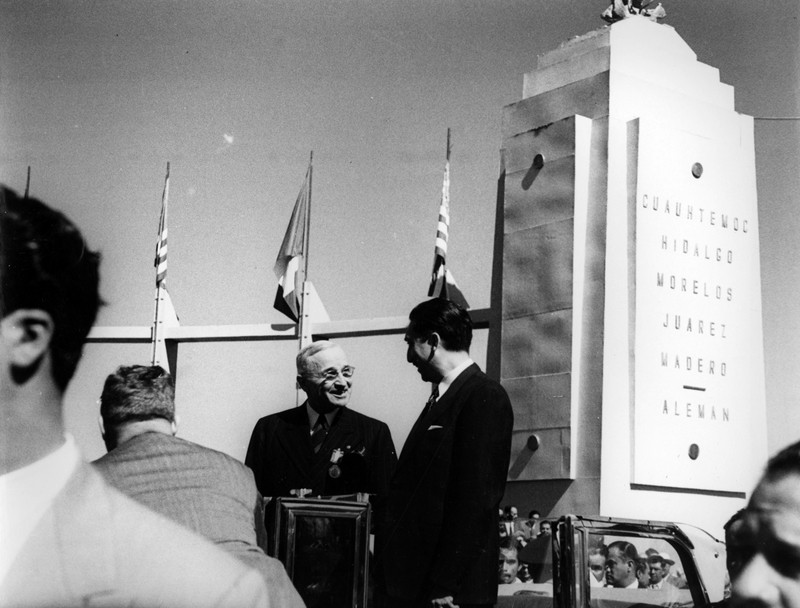
Aleman Court is a sunken courtyard and features a marble fish fountain
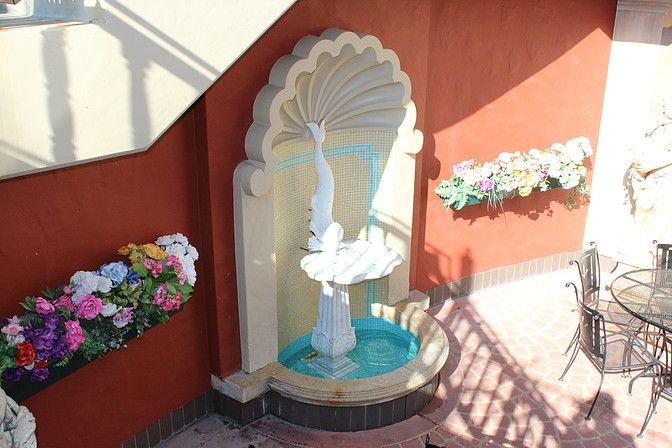
A detailed photo of the fish from the Aleman Court Fountain

Historical Marker for Aleman Court, dedicated on May 7, 1947
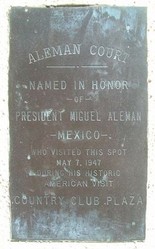
A tile mosaic and bronze plaque welcome visitors into Aleman Court.
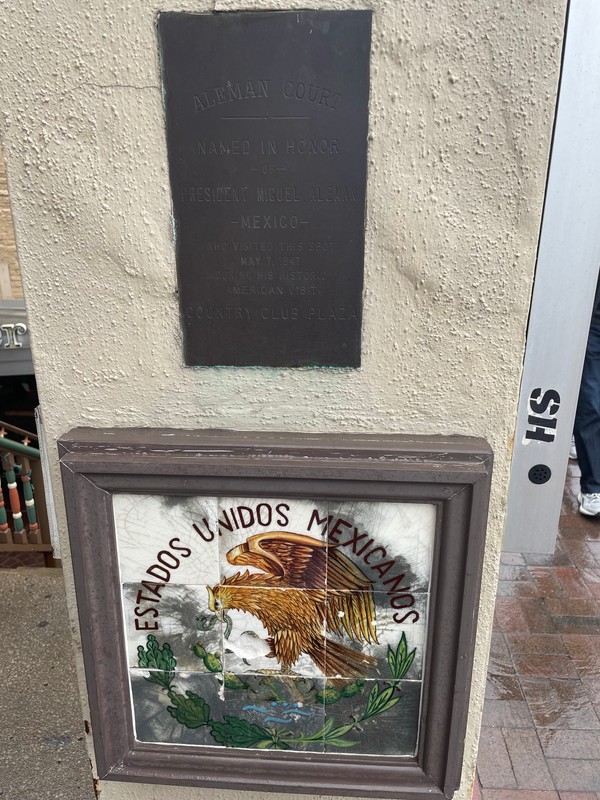
Backstory and Context
Text-to-speech Audio
Alemán Court was dedicated on May 7, 1947 in the name of Miguel Alemán, the President of Mexico from 1946 to 1952. On this day, President Alemán visited Kansas City during a week-long visit to the United States, following a visit by President Truman to Mexico City just a few months prior. Truman traveled to our bordering country on March 3, 1947 in honor of the 100th anniversary to the end of the Mexican War (April 1846 - February 1848). This was the first visit ever by a sitting president to Mexico’s capital, due to severed relations stemming from the War in which America acquired almost half of Mexico’s land, including all or parts of Arizona, California, Colorado, Nevada, New Mexico, Utah, Texas, and Wyoming. During his visit, Truman laid a wreath before the “Niños Heroes” monument of fallen soldiers and traveled to different cities as an opportunity to heal negative memories and emphasize the virtue of peace. Because of Truman’s gestures of goodwill, the two countries started the process of establishing an amicable relationship and mutual cooperation going into the Cold War.
While Alemán’s visit was in reciprocation to Truman, he wanted to be clear that it was not merely a diplomatic visit to Washington, but to the United States as a whole. Alemán started his trip on May 1, 1947, by giving a speech to a joint session of Congress and traveling through the country in the subsequent days. He visited Kansas City by invitation from University of Kansas City President Clarence Decker, Mayor William Kemp, and the Kansas City Chamber of Commerce. The invitation offered Alemán to visit the Heartland and increase goodwill, while a second invited him to present the University’s commencement address. Due to the informality of these invitations, Alemán’s advisor De la Salva was highly offended which caused some tension prior to the visit, however, the trip ended in success. President Alemán decided against giving the commencement address but did receive a small number of dignitaries that were in attendance. He was also presented with an honorary Law degree and a gift of 24 original, signed lithographs from renowned Kansas City artist Thomas Hart Benton.
While the world was in transition from World War II into the Cold War, the mutual visits between President Alemán and President Truman produced a number of accomplishments for the United States and Mexico. Both leaders embraced shared optimism and set the tone for mutual relations between the two countries for years to come, including direction for the migratory labor agreement and international credit arrangements, as well as the renewed commitment of the Good Neighbor policy.
The courtyard and fountain were dedicated in President Alemán's honor during his visit on May 7, 1947, with U.S. Presidents Truman and Eisenhower both in attendance. The fountain is made of marble and features a fish in the vertical position with its head resting on a shallow, seashell-shaped basin and its tail pointing up. The fish and basin sit on top of a fluted pedestal, as water flows from the fish's mouth into the seashell basin before it trickles down to an oval pool. The fountain is inset into a recessed tile wall topped by an arched seashell in the small, sunken courtyard of Alemán Court.
Cite This Entry
Admin, Clio and Nichole Stahly. "Alemán Court." Clio: Your Guide to History. April 18, 2022. Accessed March 14, 2025. https://theclio.com/tour/2161/30
Sources
Gipple, Justin. Pursuing a United Memory: The Truman Administration's Construction of a Collective Memory of the Western Hemisphere, MOspace. Accessed December 27th 2021. https://mospace.umsystem.edu/xmlui/bitstream/handle/10355/68408/History_2019_Gipple.pdf?sequence=1&isAllowed=y.
Alexander, Ryan M.. Fortunate Sons of the Mexican Revolution: Miguel Aleman and His Generation, 1920-1952, University of Arizona Repository. Accessed December 27th 2021. https://repository.arizona.edu/bitstream/handle/10150/216972/azu_etd_11901_sip1_m.pdf;sequence=1.
Aleman Court, City of Fountains. Accessed December 27th 2021. https://cityoffountains.org/21058-1/.
https://www.trumanlibrary.gov/photograph-records/59-72-19
https://www.trumanlibrary.gov/photograph-records/59-72-19
https://cityoffountains.org/aleman-court-fountain/
https://cityoffountains.org/aleman-court-fountain/
https://www.hmdb.org/m.asp?m=88242
Photo taken by Nichole Stahly 1/8/2022

